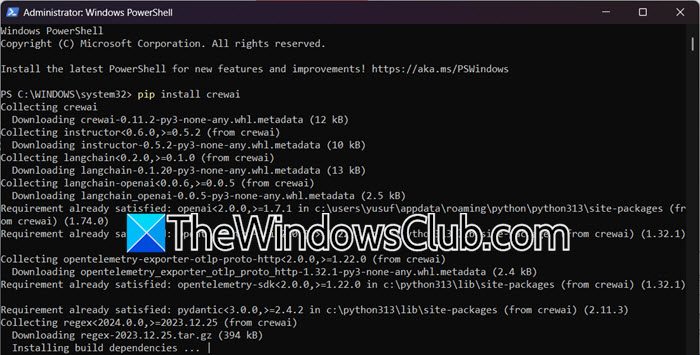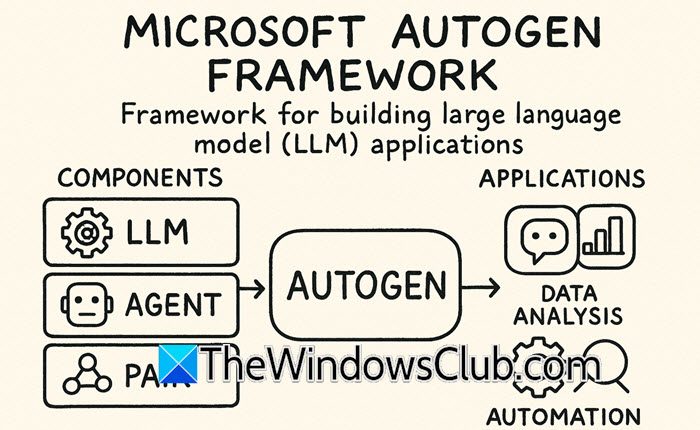Building AI is no longer just about training the model to do one task. In contemporary times, we are seeing a rise in multi-agent AI programs. A system where different AIs are coupled to function and work collectively to make things easier. However, to make this work, it’s necessary to make sure that you choose the right tool. In this article, we will walk through some of the best frameworks present in the market for building multi-agent AI programs.
Best frameworks to build Multi-Agent AI program
If you want the best frameworks to build a Multi-Agent AI program, check out the list below.
- Langchain
- CrewAI
- Microsoft Autogen
- Agno
- Motia
Let’s get started with the frameworks and know about them in depth.
1] Langchain
Langchain is an open-source framework that enhances and simplifies the development of apps powered by large language models (LLMs) like GPT-4. It provides developers with modular components such as chains, agents, and memory modules, which, combined, can create complex AI workflows. It supports integration with various LLM providers like OpenAI, Hugging Face, and Cohere.
Additionally, Python.Langchain.com offers tools for prompt management to enable the creation and optimization of prompts for different user cases. It also boasts features like context-aware memory management, retrieval-augmented generation (RAG), and dynamic prompt engineering.
To use LangChain, install it via pi, set up an LLM like OpenAI, create prompts, and build chains to manage inputs and outputs. Once done, users can add tools, memory, or agents for complex workflows. Once the chain works, integrate it into apps using Python backends, FastAPI, Streamlit, or other frameworks.
2] CrewAI

CrewAI is an open-source Python framework that is designed to build a multi-AI agent system that is quite good at collaboration and autonomy. It enables developers to create teams of AI agents called ‘crew’, where each one of them is assigned specific roles, tasks, and tools. This framework supports a hierarchical workflow that enables autonomous task delegation and interagent communication.
CrewAI.com integrates seamlessly with various large language models (LLMs), including OpenAI and open-source alternatives, and offers compatibility with over 700 apps, such as Notion, Zoom, and Stripe. For enterprises, CrewAI+ offers advanced features like a no-code interface, pre-built templates, and enhanced agent management capabilities.
Start by installing CrewAI with pip by running the command pip install crewai, set up the LLM provider, and then define the role, goals, and tools of each agent. Once done, compile them into a crew, and then launch the agents and let them perform the tasks. Users can define tools like search, calculators, or APIs and plug them into agents.
3] Microsoft AutoGen

Next is Microsoft Autogen, another open-source framework, written in Python, that allows users to build smart AI agents who work together to solve complex tasks like teammates in projects. With this, users can create agents that can interact with tools, humans, and other agents and make decisions among themselves. Its notable features include its processing of communication, where agents send messages back and forth in real time.
Moreover, it includes observatory tools like metric tracking and debugging features for a robust performance and works across different programming languages such as Python and .NET. The framework is ideal for apps that require scalability and intelligent automation.
To get started, install AutoGen via pip, set up the environment variables to use a language model, and define a UserProxyAgent and an AssistantAgent. Now, initiate the chat between them and configure them with tools or prompts. For complex tasks, create multi-agent group chats and deploy them using Python, Docker, or web frameworks. We recommend you go to microsoft.com to know more about it.
4] Agno
Agno is a developer-friendly Python framework that helps developers build AI agents based on memory, reasoning, and multimodal capabilities. It supports text, image, audio, and video inputs and outputs. To provide memory and data to agents, the framework connects with databases and vector stores like Postgres, Pinecone, and LanceDB.
Users can start with small projects like a simple assistant or try their hand at complex ones like multi-agent systems that share tasks and make decisions collectively. It features tools for reasoning, such as a chain-of-thought approach and hybrid searches. Moreover, it provides long-term memory, session storage, and structured outputs for better context-aware interactions. From building a chatbot, a data analyst tool, or something more complex, Agno is known to make it simpler for the users.
To use Agno, go to agno.com, go through their guide, check out their GitHub repo from github.com, install it, and set up your API keys. Now, define agents with specific roles and goals, and create tasks and workflows. Users can customize agents with tools, templates, and memory. After you are done, deploy agents to cloud services like AWS or GitHub, and monitor through the UI.
5] Motia
If you are looking for a code-first framework designed to build a scalable, event-driven workflow, go for Motia. It supports multiple programming languages, including JavaScript, Python, and Ruby, to facilitate collaboration across teams. The framework eliminates the need for underlying infrastructure like message queues or event brokers to let developers focus on business logic.
Motia’s workbench provides a visual interface for signing, testing, and debugging workflows through real-time logs and interactive flow diagrams. Moreover, its architecture revolves around reusable “steps” and “flows” which have the ability to listen for events, handle data processing, and trigger next steps.
Now, to move on to start the using process, install it, and create a new project using the CLI. Write modular functions that perform specific tasks, combine steps into the workflow, and execute the workflow. Users can utilize the Motia Workbench to visualize execution, view logs, and debug workflows in real-time. Go to motia.dev to know more about it.
That’s it!
Read: How to install Google ADK to build Multi Agents on Windows 11
What framework is used to implement multi-agent AI systems?
Frameworks like LangChain, CrewAI, Agno, and many more are commonly used to build multi-agent AI systems. These platforms support modular workflows, LLMs, and cloud deployment for an intelligent and cooperative workflow.
Read: How to create Powerful AI Agents without Coding?
What type of architecture is most suitable for multi-agent systems?
The most suitable architecture for multi-agent systems is a hybrid model that combines centralized and decentralized approaches. Centralized coordination ensures efficiency and a global view, while decentralized agents enable autonomy and scalability. This ensures effective communication, fault tolerance, and adaptability.
Also Read: How to build AI Agent: Beginners Guide from Microsoft.


